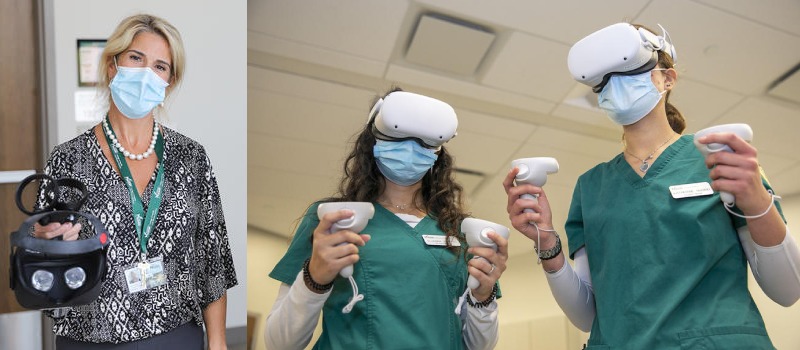The future of nursing education is coming into focus, thanks to a new pilot study that explored the potential of immersive virtual reality in replacing pediatric clinical practice for junior-level prelicensure nursing students. The study, which used a mixed-methods quasi-experimental design, showed promising results in terms of the effectiveness of VR in optimizing learning, engaging learners, and ensuring competency in future nursing graduates.
TLDR: The mean scores for students in the immersive VR training group showed an improvement in all performance domains, particularly in the subdomains of infection control, initial assessment, and oxygen therapy, when compared to the clinic-trained group.
One of the biggest challenges facing nursing schools today is the shortage of faculty and the limitations in clinical site placements. The American Association of Colleges of Nursing (AACN) has cited these issues as major hurdles in increasing enrollments and ensuring that nursing students are adequately prepared for the complexities of modern healthcare. Pediatric clinical practice, in particular, has been identified as a major challenge due to the high demand for placements, limited sites, and increasing complexity in care.
To address this challenge, educators have been exploring innovative approaches such as simulation-based training. Simulations have been found to be effective in promoting learning, improving clinical performance, and increasing confidence among nursing students. However, traditional simulations have their limitations, including the high cost of equipment, limited access to simulation centers, and the inability to fully replicate real-life situations.
Enter VR. Unlike traditional simulations, VR does not require expensive equipment and can be accessed remotely. In VR, learners wear a headset and are transported to a virtual environment that replicates real-life clinical scenarios. They can interact with virtual patients, practice procedures, and receive feedback in real-time. This becomes especially powerful when it’s integrated with a virtual campus.
The pilot study, which involved a sample of 48 junior-level prelicensure nursing students, aimed to explore the effectiveness of VR in replacing hospital-based pediatric clinical practice. Half of the students were assigned to the VR training group, while the other half received the usual hospital-based clinical training. Both groups then completed a traditional in-person simulation to compare performance outcomes.
The results were impressive. The mean scores for students in the immersive VR training group showed an improvement in all performance domains, particularly in the subdomains of infection control, initial assessment, and oxygen therapy, when compared to the clinic-trained group.

Credit: Bethany Cieslowski VR Training at George Mason University
“The use of VR continues to grow in clinical nursing practice; however, the existing body of evidence on VR, especially immersive virtual reality, is limited. These preliminary results offer promise and demonstrate the potential of immersive virtual reality in the future of nursing education and preparing the workforce of the future,” said Bethany Cieslowski, the Simulation Coordinator for the George Mason University School of Nursing, who lead this study.
These preliminary findings suggest that VR can be just as effective, if not more so, than traditional hospital-based clinical training for junior-level nursing students learning to care for acute care pediatric patients.
One of the strengths of VR is its ability to replicate real-life situations and provide learners with a sense of presence and immersion. This can be particularly beneficial in situations where access to real patients may be limited, or where the risk of harm to patients is high. VR can also be used to practice procedures that are difficult to replicate in a hospital setting, such as rare or emergent events. This can help learners build confidence and competence in these procedures, which can ultimately lead to better patient outcomes.
The study also found that students in the VR training group had a positive experience and were engaged in the training. This is important because engagement and motivation are key factors in promoting learning and retention of knowledge. VR can be a more engaging and interactive form of learning compared to traditional methods, which can be passive and disengaging.
Another benefit of VR is its accessibility. VR can be accessed remotely, which means that learners can practice and receive feedback from anywhere, at any time. This can be particularly beneficial for learners who may not have access to simulation centers or who may have limited availability due to other commitments.
It is important to note that this was a pilot study and further research is needed to confirm and expand on these findings. However, the results are promising and demonstrate the potential of VR in the future of nursing education.
In terms of practical implications, the study suggests that immersive VR simulation training can be an effective alternative to traditional inpatient clinical training for nursing students. This could help to alleviate some of the challenges that nursing schools face when trying to provide clinical placements for their students, especially in the field of pediatrics where clinical sites are limited and in high demand. The use of VR technology also offers the potential to standardize the learning experience and provide more consistency in the acquisition of essential skills, which can ultimately lead to better patient outcomes.
However, it is important to note that this study was a pilot study with a small sample size, and the results should be interpreted with caution. Further research is needed to replicate the findings and explore the potential of immersive VR simulation training in other areas of nursing education, such as adult and geriatric care. Additionally, future studies should explore the long-term effects of immersive VR training on the development of nursing competencies and its impact on patient outcomes.
In conclusion, this study offers promising results for the use of immersive VR simulation training in nursing education, specifically in pediatrics. The findings suggest that immersive VR training can be an effective alternative to traditional inpatient clinical training, providing students with a standardized learning experience that can lead to improved performance outcomes. While the results are preliminary and further research is needed, the potential of immersive VR in nursing education is exciting and offers a glimpse into the future of healthcare education. With advancements in technology and a growing interest in the potential of immersive VR, the possibilities for the integration of this technology in nursing education are endless.



